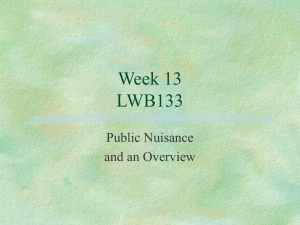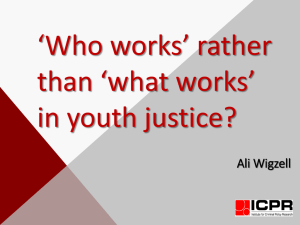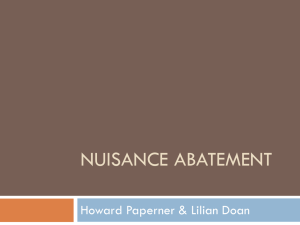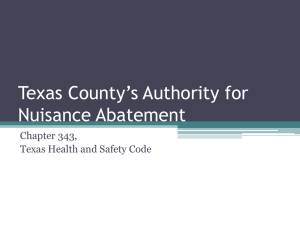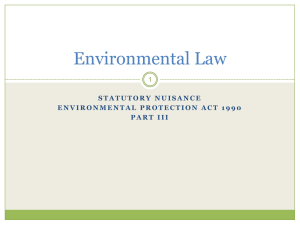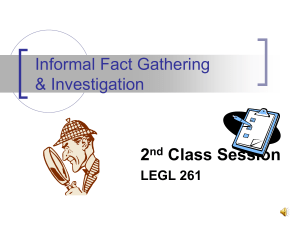Nuisance Property - Missouri Municipal League
advertisement
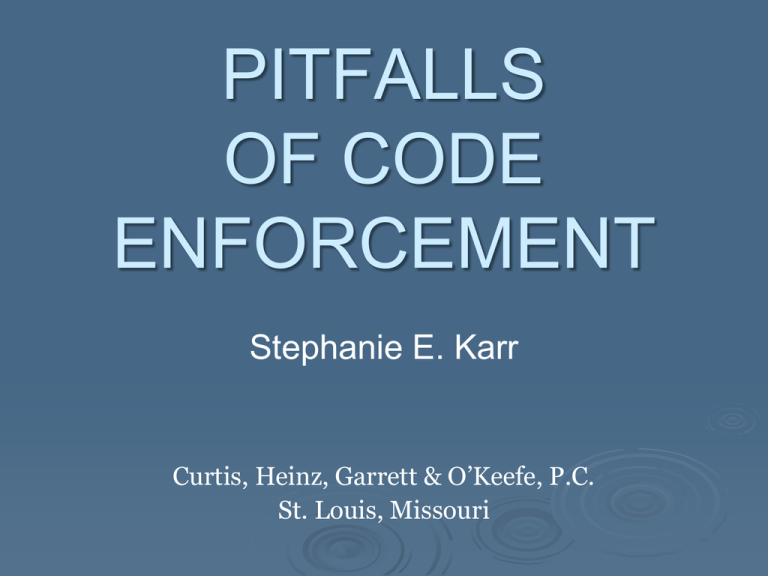
PITFALLS OF CODE ENFORCEMENT Stephanie E. Karr Curtis, Heinz, Garrett & O’Keefe, P.C. St. Louis, Missouri Exercise of Police Power Code Enforcement is a mechanism to protect the public health, safety and welfare. Code Enforcement, when utilized properly, falls under the umbrella of the city’s police power. A nuisance is a condition which causes a hazard or some detriment to the public health, safety and welfare LACK OF CAUSAL CONNECTION Causal Connection A causal link must be shown between the alleged violator and the alleged nuisance. City of St. Louis v. Benjamin Moore & Co., 226 S.W.3d 110 (Mo. 2007) (nuisance action to recover costs for abatement of lead paint in homes) City of St. Louis v. Varahi, Inc., 39 S.W.3d 531 (Mo.App.E.D. 2001) (city failed to prove that hotel's hourly rental policy, reputation and arrests in vicinity of hotel caused public nuisance of prostitution on street outside hotel); PROCEDURAL DEFICIENCIES Abatement If the property owner fails to remedy the nuisance, the city may take action to abate the nuisance The costs incurred by the city in abating the nuisance may be recovered from the property owner by issuance of a Special Tax Bill – such costs are a lien on the property. General Procedures for Abatement Written Notice reasonably calculated to reach the intended recipients Opportunity for owner or possessor to be heard by representative of the city Reasonable time for abatement by owner/possessor – “reasonable time” depends on the condition to be abated and other considerations such as weather conditions Findings and determination of nuisance after hearing Statutory Procedures Section 67.398: “…Any ordinance authorized by this section may provide that if the owner fails to begin removing or abating the nuisance within a specific time which shall not be less than seven days of receiving notice that the nuisance has been ordered removed or abated, or upon failure to pursue the removal or abatement of such nuisance without unnecessary delay, the building commissioner or designated officer may cause the condition which constitutes the nuisance to be removed or abated.” Statutory Procedures Section 71.780: “…Such nuisances may be suppressed by the ordinances of said cities, or by such act or order as the charters of said cities authorize them to adopt.” Statutory Procedures Section 71.285: Expedited procedures for abatement of high grass and weeds and litter and trash in certain cities Statutory Procedures Section 67.400 and 67.410: Vacation, Repair or Demolition of Dangerous Buildings Section 67.450 “In the event any building or structure is wrongfully demolished by a city…or is demolished without adhering to the procedures provided in sections 67.400 to 67.450, the city…shall be liable for damages as determined by a court of law in a suit brought by the party so damaged.” This section does not require ownership of the building in order to recover for wrongful demolition and, therefore, does not preclude damages and recovery by non-owners, including tenants, lien holders, or other interested parties. Defective Notice Arbogast v. City of St. Louis, 285 S.W.3d 790 (Mo.App.E.D. 2009) June, 2000: Plaintiff buys and moves into property May, 2001: Fire damages structure Plaintiff moves out and registers change of address with Post Office (did not register new address with Assessor’s Office) July, 2001: Mail to Plaintiff is returned to sender with notification of new address July 2001 – July 2002: Plaintiff receives mail at new address including mail from other City departments August and October, 2001: City had to board up building twice because of “squatters” and others who removed boards and other items from property October, 2001: City’s Building Department served notice of condemnation and potential demolition on Plaintiff by posting it on the damaged structure and by regular mail to the subject property Deadline to appeal notice or to remedy violation was October 29, 2001 Mailed Notice was returned to City No appeal was filed February, 2002: Structure demolished On Plaintiff’s action for wrongful demolition, jury awarded Plaintiffs $65,000 Action not dismissed for failure to exhaust administrative remedies because of defective notice “…that rule does not apply when the government fails to provide parties with notice and an opportunity to be heard in accordance with the requirements of due process.” Sufficient Notice Government must provide “notice reasonably calculated, under all the circumstances, to apprise interested parties of the pendency of the action and afford them an opportunity to present their objections.” If the government becomes aware prior to a taking that its attempt at notice has failed, due process requires the government to take further reasonable steps if any are available. Sufficient Notice - Posting “…in most cases, the secure posting of a notice on the property of a person is likely to offer that property owner sufficient warning of a pendency of proceedings possibly affecting his interests.” “…posted service accompanied by mail service is constitutionally preferable to posted service alone.” Quoting: Greene v. Lindsey, 456 U.S. 444, 102 S.Ct. 1874, 72 L.Ed.2d 249 (1982) Sufficient Notice - Mail “Under most circumstances, notice sent by mail is deemed reasonably calculated to apprise interested parties that their property rights are in jeopardy…But in some special circumstances, mailed notice may be inadequate…” 1. 2. 3. government knows that the party does not reside at the address and does not have access to the address recipient is known to be a person who cannot understand the notice government learns the mailed notice is returned by the post office before the taking occurs Reasons Why City’s Notices Failed Posted Notice failed: It was likely that Plaintiff did not see the posted notice (inspector acknowledged that squatters and vandals frequently removed boards and notices from condemned buildings in the area and that, in fact, City had to board the building up at least twice within 3 months) Mailing failed: Mailed notice was returned to the City. Other City departments accomplished mailings to Plaintiff. City had other avenues to reach Plaintiff Lack of Notice to Mortgagee First National Acceptance Company v. City of Utica, New York, 6:12-CV-1622 (N.D. New York) Pending Case Mortgage Company filed 1983 action against City for demolishing structure subject to Deed of Trust without notice to the company and an opportunity for the company to be heard. Last month, Court denied city’s Motion for Summary Judgment on procedural due process claims and granted mortgagee’s Motion for Summary Judgment. Municipal liability is limited under Section 1983 by Monell v. Dep’t of Social Services, 436 U.S. 658, 98 S.Ct. 2018, 56 L.Ed.2d 611 (1978) Municipal liability exists where the city’s policies or customs led to an independent constitutional violation. If a plaintiff shows that the city’s “policy” or “custom” was the “moving force” behind the violation, then he/she will prevail. Here, the City of Utica did not require its code enforcement officers to search real estate records, determine the identity of mortgagees and provide them of notice of any process that could lead to destruction of a significant asset on the property. The violation of mortgagee’s rights was a result of an official policy or custom – therefore, City subject to 1983 liability. Defective Hearing Village of Blodgett v. Rhymer, 279 S.W.3d 242 (Mo.App.S.D. 2009) July 2005 – storm caused the roof of defendant’s building to cave in One Month later – letter sent to owner ordering him to remedy and remove the dangerous building or “appear before the Municipal Court…to be heard and present evidence as to why [defendant is not] in violation of the Ordinance.” Three months later – City demolishes building but leaves basement portion and debris January, 2006 – City sends 2nd letter to defendant ordering him to remedy the existing conditions February 4, 2006 – defendant appears at Board meeting and asked if installing fence would remedy the violations February and March, 2006 – letters to defendant ordering him to perform the work April 2006 – City pays to have basement filled and debris removed City cannot recover abatement costs In City’s action to enforce its tax lien, the tax lien was determined to be invalid because defendant was not afforded an adequate hearing “…no hearing was ever scheduled for Appellant. Rather, Appellant took affirmative steps to attend a regular meeting of the board of trustees. It is unclear from the record what type of process Appellant received there, but what is clear is that Village never provided Appellant with the type of hearing required by either of its ordinances.” No Adequate Hearing Goe v. City of Mexico, 64 S.W.3d 836 (Mo/App.E.D. 2001) Process to demolish dangerous structure. Section 67.410 requires ordinance to provide for a “full and adequate hearing upon the matter, giving the affected parties at least ten days’ written notice of the hearing…After the hearings…the building commissioner…shall issue an order making specific findings of fact, based upon competent and substantial evidence, which shows the building or structure to be a nuisance and detrimental to the health, safety, or welfare…” Opportunity to ask for hearing is not enough Following the code official’s original notice and order to demolish the structure, the aggrieved party had the right to appeal the decision of the code official. If no appeal was requested, then no hearing was held. “Because the demolition ordinance did not provide for a hearing to be held automatically, it did not comply with the requirements of section 67.410 and was therefore invalid.” Owner did not waive due process challenge by not appealing the original decision. Trial court’s dismissal reversed and cause for damages remanded. Defective Notice and Hearing McNeill v. City of Kansas City: Building on City’s dangerous building list since August, 2001 McNeill purchased property in 2008 and then: - paid delinquent taxes and fees for the property - notified the City of his plans to renovate - began renovating by: obtaining architectural plans, gutting the building, removing the old roof, re-decking the roof, reframing the building and demolishing the brick and concrete patio which had collapsed By June, 2009, work stalled because of trouble with McNeill’s construction loan June 2009: City sends letter to McNeill instructing him to remove some debris that was sitting on the property along with weeds that had begun to grow there June 24, 2009: McNeill meets with code enforcement inspectors and representatives. McNeill tells them of his plans to obtain other financing. Code enforcement informs McNeill that he will have more time to obtain financing and instructs him to remove a pile of debris on the side of the building. July, 2009: McNeill’s contractor removed the debris and graded the yard. Upon completion, McNeill notified code enforcement on July 20, 2009. July 31, 2009: McNeill receives preliminary commitment for a construction loan and began notifying subcontractors. August 8, 2009: City demolished the building “without having any further contact” with McNeill, disregarding the policy of the Dangerous Buildings Division to send the property owner a pre-demolition notice. McNeill sues the City for wrongful demolition under Section 67.450 and City files counterclaim seeking the costs incurred with respect to the demolition Initial jury trial - 4 days Judgment in favor of McNeill Damages: $150,000 Motion for New Trial granted / affirmed (372 S.W.3d 906) (Flawed jury instruction) 3 day jury trial April 15, 2014 – April 17, 2014 Judgment in favor of McNeill Damages: $151,000 for property damages $55,000 for personal injury Prejudgment interest (9%) on property damage amount commencing September 2, 2010 Costs assessed to City: $1,900.65 Defective Findings and Conclusions Woodson v. City of Kansas City, 80 S.W.3d 6 (Mo.App.W.D. 2002) Department issued order to demolish storage garage which was appealed to the City’s Property Maintenance Appeal Board. The Board held evidentiary hearing. Following evidence, the Board voted and issued Findings and Conclusions merely affirming the previous demolition order. The Board did not set forth specific conditions and defects which caused the garage to be dangerous. Ordinance set forth several conditions which showed a structure to be dangerous, such as: 1. The exterior walls or other vertical structural members list, lean or buckle to such an extent that a plumb line passing through the center of gravity does not fall inside the middle one-third of the base. 2. A portion thereof has wrecked, warped, buckled or settled to such an extent that wall or other structural portions have materially less resistance to winds or snow… Neither the Department’s demolition order or the Board’s decision made findings which set forth these conditions to support a decision that the building was dangerous. Case remanded back to Board with instructions to remand matter to department for specific findings as to particular conditions of building. Demolition delayed. NO WARRANT Administrative Search Warrants Camara v. Municipal Court of the City and County of San Francisco, 387 U.S. 523; 87 S.Ct. 1727, 18 L.Ed.2d 930 (1967) Bezayiff v. City of St. Louis, 963 S.W.2d 225 (Mo.App.E.D. 1997) Warrants Necessity of warrant Requirements Probable cause Affidavit Application for the warrant Definition of area and work covered Warrant Execution Return Process Is Not Meant To Be Easy An “individualized review” is necessary to provide “the traditional safeguards which the Fourth Amendment guarantees to the individual.” Public goals and need for expediency considered Camara: “…it is vigorously argued that the health and safety of entire urban populations is dependent upon enforcement of minimum fire, housing, and sanitation standards, and that the only effective means of enforcing such codes is by routine systematized inspection of all physical structures…we think this argument misses the mark. The question is not, at this stage at least, whether these inspections may be made, but whether they may be made without a warrant…It has nowhere been urged that fire, health, and housing code inspection programs could not achieve their goals within the confines of a reasonable search warrant requirement.” Liability Considerations Is it the “policy” or “custom” of the City NOT to obtain warrants? Procedure to obtain warrants Adequate training of code enforcement officers No Qualified Immunity Haefner v. City of Philadelphia: Summary Judgment based on qualified immunity of inspector and Department Head denied Camara case was decided in 1967 building code inspector had been involved in another lawsuit concerning lack of warrant city had warrant provisions in Code City had conducted training session Department Head – did not object to employee’s conduct SELECTIVE ENFORCEMENT AND SUMMONS OVERKILL Generally, the failure of municipal authorities to enforce a zoning ordinance against some violators does not preclude its enforcement against others. Kansas City v. Wilhoit, 237 S.W.2d 919 (Mo.App. 1951). But, selective enforcement or using the process to a greater extent than is necessary may lead to a Section 1983 action. Williams v. City of Carl Junction, Missouri, 480 F.3d 871 (8th Cir. 2007) and 523 F.3d 841 (8th Cir. 2008) (award of attorneys fees to City reversed) Garcia v. City of Trenton, Missouri, 348 F.3d 726 (8th Cir. 2003)
